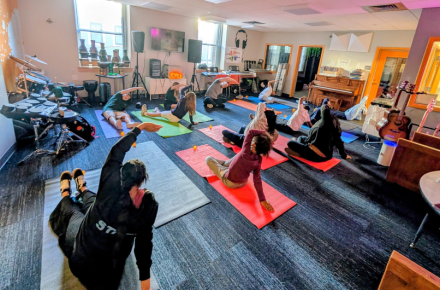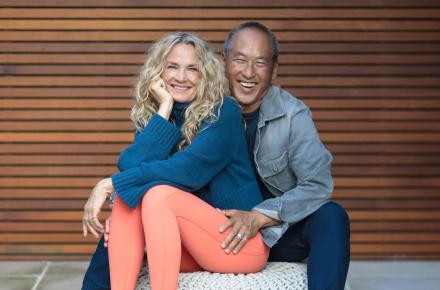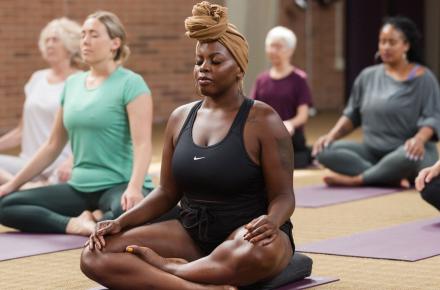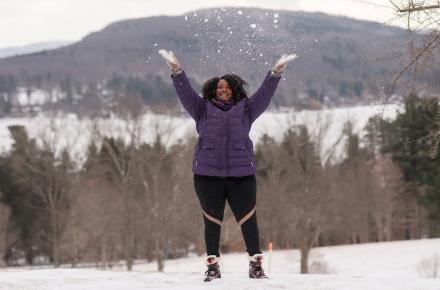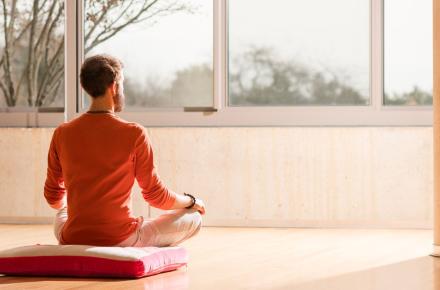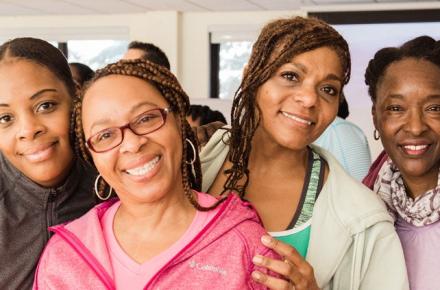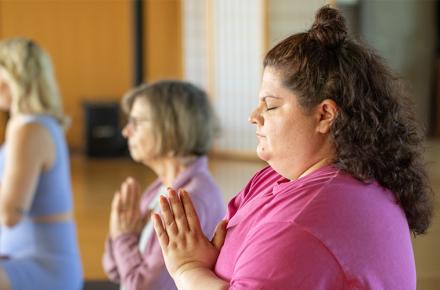The Surprising Benefits of Chair Yoga

by Cheryl Kain
Thirty-five years ago, when one of Lakshmi Voelker’s students was diagnosed with arthritis and no longer able to get down on the floor to practice yoga, Lakshmi was struck with inspiration. She developed an entire sequence that her student could practice on a chair—and she hasn’t stopped practicing and teaching Chair Yoga since.
“I love Chair Yoga because it’s accessible to me in any chair, anywhere,” Lakshmi says. “Anyplace I go, whenever I sit on a chair, I come into Sitting Mountain immediately. That always guides me to remember my roots.”
Lakshmi developed her innovative Chair Yoga approach in 1982. It’s an accessible, inclusive way for yogis living with physical and weight differences to gain all the benefits of yoga, without stressing their joints, supporting their body weight, or worrying about balance. In 2005, Lakshmi began to train teachers in her method and has certified more than 1,500 teachers nationally and internationally. In just the first three years of the program, she certified more than 400 people in the United States, Canada, and Japan.
The training is for everyone, not just yoga teachers—physical therapists, occupational therapists, doctors, lawyers, nurses, social workers—anyone who is interested in learning and teaching a new modality of yoga that’s accessible for everybody, says Lakshmi. Those who aren’t yoga teachers should have at least 15 hours of yoga experience, which can include classes, videos, and/or private yoga sessions.
I have my own history with Chair Yoga, so I was excited to talk with Lakshmi about this accessible and inclusive form. Years ago, I had used a chair to modify yoga for myself when I had a knee injury. And this past winter, I taught Gentle Beach Yoga at a resort in Grand Cayman to students of various levels, ages, and abilities. There was a core group of students who were comfortable practicing on the sand, a few who appreciated the modifications that I always offer, and also a few who felt uncomfortable or unable to get up and down. They would stand during class while I modified the poses so they could stay on their feet. I believed that these students could benefit more from practicing using a chair than standing, so I brought a few chairs out on the sand during every class.
Their participation inspired me to read up on Chair Yoga, and I began offering Yoga for the Chair classes twice weekly. I had my own judgments about Chair Yoga—sure, we could lift our legs on a chair, but how could we do Downward Facing Dog? Or the Warrior series? I was surprised and excited to experience how so many of the asanas translate to the chair. After a Chair class, I found myself relaxed but not sore, and more energized than exhausted. And the range of movement available was a wonderful discovery. I found that I could stretch more deeply during One-Legged Down Dog in a chair than I ever could on the mat. My arm extension during Triangle Pose stretched my side body more, without torque to my knee or neck.
Lakshmi has experienced the same benefits; she says that the deeper stretch that Chair Yoga offers enhances her practice when she gets back on the floor. “When we do the Warrior series using the chair, if someone came from behind me and let me know that they were going to gently pull that chair out from under me, I would be a lot deeper in the pose than I would be on the mat,” she says. “So when I do get to the mat after my chair sequences, I’m much deeper and stronger in most of my poses.”
I couldn’t imagine that the most young and fit among my students would be as enthusiastic as they were about Chair Yoga, but even the kids joined in and loved it. Most of my yoga students had heard of Chair Yoga back home but had been afraid to try it. A woman in her early 70s, who had had multiple back and neck surgeries and been told by her doctors she would “never do yoga again,” was empowered and heartened to discover that she was at home in the chair.
The methodology is also ideal for office employees, Lakshmi says. “Chair Yoga is great for ‘desk warriors’ in corporations—people who are confined to their desks in a cubbyhole. They can do the eight spinal movements; they can come into Sitting Mountain throughout the day; and if they engage the press points in the feet and sit bones, they will start to build muscle and bone mass while working at their job. Anyplace they’re sitting, they can build strength, just by activating the asana or perfecting the pose. ”
A few years ago, Lakshmi was diagnosed with osteopenia. “When I had it for a couple of years and just couldn’t shake it, the doctor eventually wanted to put me on medication. I said, ‘No, thank you,’ and then I devised 12 Chair Yoga asanas to build muscle mass—regular mat poses that I brought to the chair.” She practiced the asanas daily and, after eight months, returned for another bone mass test. She no longer had osteopenia. Chair Yoga works.
Sitting Mountain Pose
All Chair Yoga asanas begin with and return to Sitting Mountain. Here’s how to build this foundational pose.
- Sit up straight near the front edge of the chair; this will engage your abdominal muscles. Imagine magnets pulling up the crown of your head and pulling down the sit bones and feet.
- Move some of the flesh away from your sit bones and anchor them on the chair.
- Check that your hips, knees, and ankles are at right angles.
- Place your fists side by side between your legs, in the soft flesh right above your knees to align them hip-width apart.
- Place feet parallel to each other, with the second toe of each foot pointing forward. Lift up toes and locate the press points on the sole of each foot (on the pad under the big and little toes, and on the center of heel). Push press points down into the floor. Relax toes back down, imagining that you are going to stand up.
- “Zip up” the pubic bone area and melt down the sacrum and lumbar in a gentle pelvic tilt. Draw the belly in.
- “Swing” the heart and solar plexus forward and up.
- Relax the arms down by your sides with the palms facing forward and the thumbs turned back, as far as comfortable, to open the rotator cuff.
- Roll the shoulders up, back, and down (without rounding or collapsing).
- Place the hands on the upper legs, either palm up to receive or palm down to get grounded. Touch the thumb and pointer finger together and extend the other three fingers.
- Lift the neck up from the “basket” of the shoulders, and lift the crown of the head toward the ceiling. The chin is parallel to the floor and pressed back just slightly to align the cervical vertebra and spine.
- Close the eyes or maintain a soft downward gaze.
Register for Lakshmi Voelker Chair Yoga Teacher Training at Kripalu.
Cheryl Kain, a writer and certified yoga teacher and meditation educator, looks forward to becoming certified in Lakshmi Voelker Chair Yoga.
© Kripalu Center for Yoga & Health. All rights reserved. To request permission to reprint, please email editor@kripalu.org.





